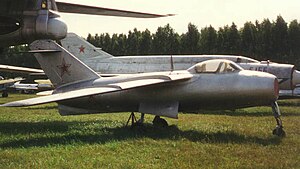La-15
| La-15 | |
|---|---|
 |
|
| La-15 at Central Air Force Museum, Monino | |
| Role | Fighter |
| Manufacturer | Lavochkin / Plant 21 "Sokol" |
| First flight | January 8, 1948 (Aircraft 174) |
| Introduction | 1949 |
| Retired | 1953 |
| Primary user | Soviet Air Force |
| Number built | 235 |
| Developed from | Lavochkin Aircraft 174 |
The Lavochkin La-15 (Plant 21 product code Izdeliye 52, USAF reporting name Type 21,NATO reporting name Fantail), was an early Soviet jet fighter and a contemporary of the Mikoyan-Gurevich MiG-15.
Lavochkin had produced a line of prop powered fighters in World War II. The Lavochkin La-150 was its first response to a 1945 order to build a single-seat jet fighter using a single German Junkers Jumo 004 turbojet from the Me-262 which first flew in September 1946. The Lavochkin La-152 which flew in December 1946 moved the engine to the front of the nose, which reduced thrust loss. The Lavochkin La-160 was the first Soviet fighter to apply swept wings, and flew in June 1947.
The Lavochkin La-168 first flew on April 22, 1948. (The American F-86 Sabre had first flown in October 1947.) It was designed to use the new turbojet based on the Rolls-Royce Nene in response to a 1946 request for an advanced swept-wing jet fighter capable of transonic performance. The engine was placed behind the pilot, but with a high-mounted wing and T-tail compared to the similar MiG-15.
The La-15 which reached mass production was the outcome of a series of development aircraft that began with the Aircraft 150 bomber in 1945 and culminated in Aircraft 176, later in 1948. These aircraft were designed for British engines, Rolls-Royce Derwent V and Rolls-Royce Nene, acquired by the Soviets in 1947 and then copied as the Klimov RD-500 and Klimov RD-45 respectively. The Derwent-powered Aircraft 174 was designed as a backup for the main program, the Nene-powered Aircraft 168, in case the British failed to deliver more powerful Nene engines with afterburners (which they did fail to deliver). The first prototype of Aircraft 174 was flown just 9 days after its counterpart the Mikoyan-Gurevich I-310, on January 8, 1948. The first prototype was however lost on May 11, 1948 due to vibrations. Trials were continued with an improved second prototype, designated Aircraft 174D, which underwent State Acceptance Tests from August to September 25, 1948. In comparison with the Nene-powered MiG-15 it had almost the same maximum speed and better maneuverability, with somewhat reduced rate of climb. The type was ordered into production in September 1948, even while Aircraft 174D was undergoing flight trials, and given the official designation La-15 in April 1949.
...
Wikipedia
